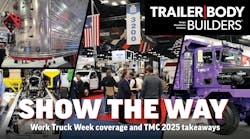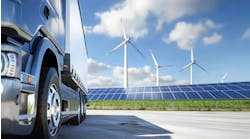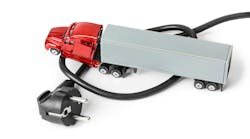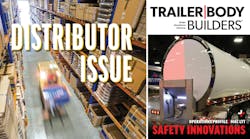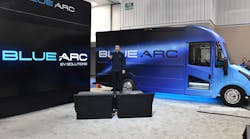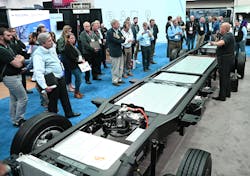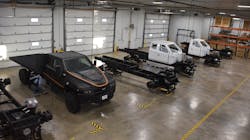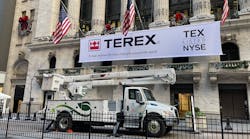There are good reasons for many fleets to switch to electric power. But converting a fleet of work trucks to run on electricity is no flip of a switch. To start with, producing a work truck is far from simple. These vehicles are often constructed in multiple stages and by multiple manufacturers. Converting from powering them with internal combustion engines to electric drive systems piles on the complexity.
Yet, whether due to the pursuit of improved cost, productivity, regulatory or sustainability outcomes, or some combination thereof, the work truck industry’s interest in electric vehicle (EV) fleets is gaining traction fast. Most of these vehicles will be battery-electric vehicles (BEVs), meaning they are powered solely by batteries installed within the vehicles’ frames that provide all the “juice” needed to drive the powertrain.
Some EVs may be hybrids, equipped with both electric drives and (typically) gasoline engines for light-duty work, such as pickups.
While EVs may not be suitable for every work truck application, those that work from central depots, such as refuse collection and utility service vehicles, are excellent candidates for going electric. What’s more, this green technology continues to advance as additional options for electric trucks become available and the batteries that make their wheels turn become more efficient.
Why switch?
Electric power appeals to many fleet operators for several compelling reasons. These include the potential for EVs to deliver a lower total cost of vehicle ownership, thanks to reduced fuel spending and lower maintenance costs; to eliminate tailpipe emissions of greenhouse gases as required by federal and state regulations; to help achieve corporate environmental sustainability goals; and, in many cases, to enable quiet operation on urban streets and during overnight operations.
Because they are purpose-built for defined missions, work trucks are complex vehicles that require considerable engineering and overall effort by fleets and their suppliers to put them on the road. On the other hand, these job-specific trucks are likely to deliver a much longer life cycle than mass-produced vehicles.
The specific reasons why a particular fleet would consider shifting to lower-emissions vehicles — indeed, the bar now is as low as zero emissions — should be clearly defined and weighed prior to starting any EV conversion. Among the key considerations are:
- Lowering operating and life cycle costs
- Supporting energy independence
- Reducing energy costs
- Improving the fleet’s public image
As bright as the electric future appears, shifting a single truck or an entire fleet to electric power takes a lot of planning. That starts with attaining leadership buy-in.
From there, consider the electric ecosystem that will surround and support these work trucks.
That’s why the next step is for the fleet to form cooperative partnerships with vehicle builders and their EV component suppliers, battery manufacturers, electric utilities, and providers of on-site charging infrastructure.
Back to basics
When communicating with these partners, be sure to define the fleet’s drive cycle and duty cycle for each type of truck to be converted. These are the two pillars to define a work truck’s mission and help scope out how to accomplish that mission. Avoid the common pitfall of confusing the two.
The drive cycle defines how a vehicle is used, while the duty cycle defines how much a vehicle is used. These measurements are mutually inclusive, and both define how vehicles are utilized. They are equally important, especially when designing EVs and the infrastructure to support them.
However, they are vastly different. In simple terms, the drive cycle measures physical points, such as vehicle speed, starts and stops, idle time, and power take-off (PTO) power export. On the other hand, the duty cycle measures the length of average operating time, operating cycles per period, total distance driven, and percentage of loaded vs. empty operation. Both measurements are crucial when considering all aspects of electrifying the fleet.
Engaging with suppliers
Most vocational trucks are built in multiple stages by multiple manufacturers. While some fleets work with a single source, such as a fleet management company, that may provide a turnkey solution, others will interact with several partners, perhaps the chassis supplier, an auxiliary equipment supplier, and an upfitter.
While industry standardization keeps evolving, technology also continues to advance. Taking time on the front end to evaluate all options, from the capabilities of the electric drive system under consideration to how the truck batteries will be charged, can ensure that the final spec’d unit serves its intended purpose. Following a methodical procedure and engaging the right people at the right time is critical.
With almost every vehicle change, there are hidden and unanticipated costs and other challenges that creep up and can derail or significantly delay a vehicle spec’ing campaign. Don’t overlook costs and prices beyond the power unit when planning. These could involve facility upgrades, technician training, or operational requirements based on vehicle limits (range, towing, etc.). You may find that vehicle design is the easy part. Designing and installing charging and maintenance infrastructure can get complicated.
Charging ahead
Many fleets, especially in the work truck sector, cannot rely on public infrastructure, either for fueling or charging. Therefore, it’s critical to talk to a utility company about the supply of power available and how/if it can support the vehicles.
Next, develop a long-term plan for infrastructure. Just as making mid-build change orders on trucks, or modifying them after delivery, is expensive, planning for infrastructure will be much more cost-effective. Charging infrastructure can be a very costly afterthought. It’s essential to plan not just for current needs, but for tomorrow’s as well. This involves consultations, designing, permitting, constructing, managing, and, finally, activating. Having the right partners lined up and communicating with them effectively is of utmost importance.
Diving deeper into charging with a utility and charging suppliers will reveal that most fleets will need two types of charging solutions. Depending on duty cycles, plan to install enough “overnight” or slow-charging stations so vehicles returned to their depot can be charged up steadily over a period of hours to be ready for their next shift, typically each morning. To supplement this, a fleet may install a smaller number of “opportunity” or quick-charging stations that can rapidly “top off” the charge of a vehicle on duty to extend its range as needed. Light-duty fleets may also have drivers charge their vehicles overnight at their homes. This means they’ll need a plan for installing chargers at their employees’ homes and a reliable driver reimbursement system.
Bear in mind that ultimately, it’s the fleet’s continuing responsibility to ensure that charging stations are installed to meet building and fire codes and are operated safely by trained personnel. In addition, work with charging suppliers so that charging data will be collected and processed properly to better inform management on the performance of EVs and their chargers.
Measuring success
While EVs are a proven green solution, this shouldn’t obscure the fact there is no single technology that is the only answer to cutting greenhouse gases and fuel costs. For a given fleet, the best option might include other advanced fuels and technologies, such as natural gas and propane engines or, further off, fuel cell power. And that’s not to mention advances that may occur in conventional diesel- or gasoline-fueled powertrains.
In the end, vehicles need to perform specific tasks to meet organizational goals. By defining those, each fleet can establish its own measurement of success. While these goals can differ by fleet, whether they’re financial, environmental, or regulatory, success means getting the commercial vehicle’s job done effectively and efficiently.
Christopher Lyon joined NTEA as director of fleet relations and Green Truck Association (GTA) fleet liaison in 2015. In this role, he connects distributors/manufacturers and end-user fleets while staying abreast of current issues impacting the fleet community.
